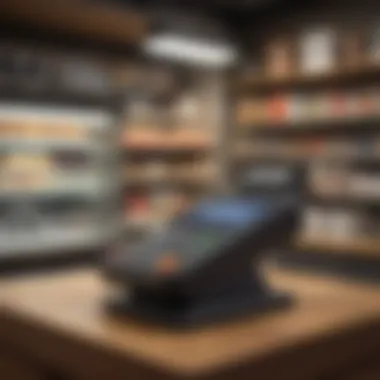Understanding the Costs of a POS System for Businesses


Intro
In today’s fast-paced business world, understanding the various costs associated with a point of sale (POS) system is quite crucial. Whether you run a small boutique or a large restaurant chain, a well-implemented POS can streamline operations, enhance customer experience, and improve financial management. Investing in a POS isn’t just a financial commitment; it’s a strategic decision that can shape how your business operates in the long run. This exploration reveals the costs you might not have thought about and why knowing them is so important.
Overview of Financial Products
Definition and significance
To put it simply, financial products encompass various instruments that facilitate transactions, manage investments, and handle cash flow. In the context of POS systems, these products include the hardware and software necessary to manage sales, inventory, and customer data. Having a grasp of these offerings can enrich your understanding of overall expenses. The significance? Well, a robust POS system can save time, reduce manual errors, and ultimately boost your bottom line.
Types of financial products available
The goodies that come with POS systems can include:
- Hardware: This consists of cash registers, barcode scanners, and receipt printers.
- Software: Various applications tailored to different industries, focusing on sales, inventory, and reporting.
- Payment processing fees: Costs associated with credit card transactions and digital payments.
- Maintenance & support services: Essential for addressing technical issues that might arise.
- Add-ons: Features such as loyalty programs or employee management tools, which can elevate your service.
Identifying the right mix of these products is like piecing together a puzzle – you want each piece to fit well to see the full picture.
Key Attributes
Interest rates and returns
When delving into the costs of a POS system, it’s vital to consider not only the initial investment but also long-term implications. While hardware and software can come with a one-time fee, things like payment processing fees may surface regularly, directly impacting your cash flow. Understanding the interest rates tied to financing options can assist you in determining the true cost of owning a POS system.
For instance, many businesses opt for leasing their equipment, leading to monthly payments rather than a lump sum. Evaluating these figures in conjunction with what you stand to gain—like improved efficiency and streamlined operations—will give you a clearer picture of your financial outlook.
Risk factors associated with each product
Every investment carries its risks. Whether you’re a small ice cream shop or an upscale restaurant, consider these factors when weighing your options:
- Technology obsolescence: As technology evolves, your POS system may need upgrades or replacements sooner than expected.
- Downtime risks: If your system crashes, it could halt transactions, resulting in lost sales.
- Data security breaches: Investing in a POS opens up potential vulnerabilities; safeguarding customer data is imperative.
In essence, being aware of these risks enables better preparedness, thus ensuring smoother sailing in the operational seas.
Investing in a point of sale system is not just about immediate costs. It’s about the long-term benefits that a well-chosen system can bring to your business as it evolves.
As you navigate through the intricate world of POS systems, remembering these key attributes will help you gauge not only the costs but also the overall value they can bring to your organization.
Prologue to Point of Sale Systems
In today’s business environment, the term "Point of Sale" (POS) has become more than just industry jargon; it’s a keystone for retail and hospitality industries that aim for efficiency and customer satisfaction. Knowing the intricacies of what a POS system entails is essential for any entrepreneur or financial enthusiast looking to optimize their investment choices. A well-functioning POS system can streamline transactions, enhance reporting capabilities, and streamline customer interactions, all of which are crucial factors for measuring success in modern business.
Definition and Purpose of POS Systems
At its core, a Point of Sale system is where the transaction occurs between a customer and a business. Generally, it integrates hardware and software to facilitate sales, manage inventory, and track customer engagements. To put it simply, it acts as the hub for sales operations—think of it like a digital cash register.
The essential components typically include a terminal, a barcode scanner, a receipt printer, and a payment processor. This not only orders the checkout process but also ensures the business has accurate insight into sales and inventory, leading to more informed decision-making down the road.
Importance in Modern Retail
The significance of POS systems in today's retail landscape cannot be understated. Without modern POS systems, businesses would be operating in the dark with regards to transaction data, efficiency, and customer satisfaction. Here are some points worth considering:
- Real-Time Data: Integrating a POS system provides access to real-time data, allowing business owners to see what sells best, when products are most in demand and how much stock is left.
- Customer Experience: A quick and efficient POS improves the shopping experience, reducing wait times at checkout, and enhancing customer satisfaction.
- Operational Efficiency: Automation in inventory management reduces human error and frees up employees to focus on providing better customer service.
As we delve deeper into this article on understanding the costs of implementing a POS system, it’s necessary to remember that investing in the right technology can yield significant returns in the long run. The insight gained will not just inform choices related to costs but also illuminate the potential of POS systems to escalate profitability and enhance customer experiences.
Components of POS Systems
When delving into the mathematics of a Point of Sale system, understanding its components becomes crucial. Each element plays a distinct role, contributing to the overall functionality an efficiency of the system. These components—hardware and software—constitute the backbone of any POS solution, influencing everything from transaction speed to data management. Without grasping the essence of these components, business owners might find themselves steeping in unnecessary costs or facing operational issues down the line.
Hardware Requirements
Terminal Devices
Terminal devices are the face of a POS system. They are the equipment that cashiers or staff interact with to process sales. One of the key characteristics of terminal devices is their operational capability; they must provide quick access to inventory and customer data. A commonly chosen option is the all-in-one POS terminal. These systems pack everything from a touchscreen interface to built-in payment processing in a compact design.
The unique feature of terminal devices lies in their integration. They facilitate multiple payment methods—from credit cards to mobile wallets—streamlining the customer experience. However, investing in high-end terminal devices can be pricey upfront. While they might seem like a worthy investment for speed and efficiency, small businesses should weigh the immediate expense against anticipated growth and further possible needs.
Peripheral Devices
Peripheral devices enhance the functionality of terminal devices and play an essential role in the POS experience. Devices like barcode scanners, receipt printers, and cash drawers add layers of ease to the transaction process. One significant characteristic is their ability to work in tandem with the terminal devices, ensuring a seamless flow of information during checkout.
For instance, a reliable barcode scanner can drastically speed up the checkout process, reducing wait times and enhancing customer satisfaction. The unique feature of these peripherals is their modularity; businesses can add or replace them as needed without the hefty price tag associated with completely new systems. However, some peripherals may require specific compatibility with terminal devices, which can lead to additional costs and complexities in the setup.
Cables and Connectors
Cables and connectors often go unnoticed, yet they are vital to the performance of a POS system. Their quality can affect the reliability and speed of data transmission. A notable characteristic of these components is that they form the physical links between all hardware elements, allowing communication and coordination. For instance, using high-quality USB cables helps ensure faster data transfer rates between the terminal and peripherals, which can be a game changer during peak operation times.
The unique feature here is their varied application; they come in multiple types and sizes, which means businesses need to choose carefully. Cutting corners on cables might save a few bucks today, but it can lead to performance problems tomorrow. Missing connectors or poor-quality cables can cause frustrating downtime, impacting service speed and customer experience.
Software Solutions
After understanding the hardware, the next pivotal aspect is the software solutions that operate on those devices. Software can significantly influence how efficiently transactions are processed, how inventory is managed, and even how data is analyzed for overarching business decisions.
Cloud-Based Options
Cloud-based software solutions have gained traction owing to their flexibility and accessibility. One prominent characteristic is that they allow businesses to access their POS from various devices and locations, providing a significant advantage for multi-location enterprises. Business owners can manage sales data and inventory in real-time without being tied down to physical locations.


A unique feature of cloud-based options is their automatic updates. Businesses can rest easy, knowing that they always have the latest features without worrying about manual installations. However, it's crucial to note that these solutions often operate on a subscription basis, which can add up over time. Smaller businesses may find it tough to keep up with recurring subscription fees.
On-Premises Solutions
On-premises software solutions are the traditional setup, hosting all information on local servers. Their defining characteristic is greater control—businesses maintain their data directly, which can be a significant benefit for those concerned about security and privacy. For instance, restaurants that manage sensitive customer information often prefer on-premises systems to ensure data integrity.
The unique advantage here is the upfront cost may be lower compared to cloud solutions, as there's no ongoing subscription fee. However, these systems can become outdated quickly, and businesses are responsible for maintaining and upgrading the software themselves, potentially leading to unexpected expenses.
Breaking Down Costs
Understanding the cost of a POS system goes beyond just a single price tag. It involves a detailed look into various components that can significantly impact a business's bottom line. Breaking down these costs is crucial not only for budgeting but also for making informed decisions about which systems to implement and how to align them with business goals. This analysis highlights initial investment costs and ongoing expenses, offering insights into how each factor plays into the bigger picture of ROI.
Initial Investment Costs
The initial costs for a POS system are usually the most eye-catching, requiring upfront financial commitment. It's important to dissect this part because it sets the stage for future expenses and impacts overall financial strategy.
Hardware Expenses
When you think of hardware expenses in a POS setup, think of the physical equipment you’ll need. This includes registers, scanners, and tablets. A fundamental point to acknowledge here is that having reliable hardware can drastically reduce downtime during busy hours, ultimately affecting customer satisfaction and revenue.
Many businesses lean towards well-known brands like Square or Clover for hardware. These devices are robust, and a key characteristic is their user-friendly interfaces, allowing staff to operate them with minimal training.
The unique feature of hardware expenses can often be seen in the long-term value it provides. For example, investing in durable terminals may seem costly upfront but can save you in repairs and replacements down the line. However, don't overlook the fact that sticking with cheaper, less-efficient hardware can lead to bigger headaches, especially when it slows down service.
Software Procurement
Software procurement involves acquiring the software that powers your POS system, which usually comes as either a standalone purchase or as a subscription. The contribution of this aspect is critical as it influences how well the system integrates with other tools and manages daily operations.
A notable characteristic of software solutions is the level of customization they offer. Some systems, such as Toast, provide tailored options that fit various business models, like restaurants and retail.
A unique feature here is the ability to analyze sales data and generate reports automatically. This can significantly ease decision-making. However, businesses must be wary of the potential disadvantages such as the learning curve involved and the ongoing cost that comes from subscription models, which can add up over time.
Installation Fees
Installation fees are often an underestimated part of the initial investment. This cost covers setting up the hardware and software systems, making sure they work harmoniously together. A key element is that a properly installed system minimizes disruptions to daily operations, allowing staff to quickly return to serving customers.
Many art using certified professionals ensures that the installation goes smoothly. This characteristic of hiring experienced personnel can mean the difference between a lifelong working system and a constant source of headaches if there are any glitches.
That said, installation fees can sometimes be surprising. If a provider has complicated setups, the costs can skyrocket. Planning ahead and getting a clear quote before signing contracts can save businesses from unexpected financial hits down the line.
Recurring Costs
Recurring costs are the ongoing expenses that a business must account for in their financial planning once they have the system up and rolling. These costs matter as they can eat into profit margins if not monitored closely.
Subscription Fees
Subscription fees refer to the charges incurred from software access on a regular basis. This aspect is increasingly common, as many modern POS systems adopt a SaaS (Software as a Service) model. The benefit of this model is predictability in budgeting. Knowing exactly how much to allocate monthly or yearly can provide peace of mind.
A primary characteristic of subscription-based models is often the frequency of updates, making sure that businesses are using the latest features without additional costs. However, an underlying issue can be the cumulative effect; over time, these relatively small monthly fees can add up significantly. Businesses need to weigh the ease of access against the potential financial impact.
Maintenance Costs
Maintenance costs are crucial for keeping the system running optimally. This encompasses everything from software updates to hardware repairs. It plays an essential role in ensuring the business runs smoothly, especially in environments where time is money.
One key aspect of maintenance costs is that they can vary based on the level of service. Some companies offer comprehensive coverage, which may seem expensive but can actually save money during critical times. The unique feature to consider is whether the costs are predictable or fluctuate based on usage, which can complicate budgeting.
Transaction Fees
Transaction fees represent the charges incurred each time a sale occurs. Many businesses overlook this detail, but it can accumulate to substantial amounts over time. Depending on the payment processor, these fees can vary widely.
Key characteristics of transaction fees are their predictable nature; businesses can estimate costs based on anticipated sales volume. On the downside, during high sales periods, these fees may sharply increase, impacting profit margins. Being aware of the nuances around transactional models and negotiating terms with payment processors can make a big difference.
In Summary: The financial landscape of a Point of Sale system is multifaceted. By breaking down the costs into initial investments and ongoing expenses, businesses can better prepare and align their strategic approach for maximum ROI, ensuring they are not just throwing money at a system but are making sound financial decisions.
Factors Influencing POS Costs
When considering the purchase of a Point of Sale system, it’s pivotal to understand the various elements that drive costs. These factors not only influence the initial outlay but also the long-term financial implications for businesses. Different businesses will face diverse challenges and have unique requirements that directly affect their POS-related expenses.
Business Type and Size
Retail vs. Hospitality
The nature of the business significantly affects the type of POS system required. Retail settings often need a system that can handle a high volume of transactions efficiently. They may prioritize features like inventory management or customer tracking. On the other hand, hospitality businesses, like restaurants or hotels, demand systems that streamline service delivery—focusing on table management and quick payment processing.
For instance, a retail store might choose a system like Square that integrates sales and inventory seamlessly. This is beneficial as it keeps track of stock levels in real-time, helping avoid shortages. In contrast, a hospitality business may lean towards Toast, which is designed to handle complex orders from tables and split bills easily. Each option, while serving its market well, presents unique pricing structures, potentially affecting overall costs depending on the specific service chosen.
Single vs. Multi-Location Businesses
When it comes to business scale, single-location businesses may encounter different challenges compared to their multi-location counterparts. A single store usually has more straightforward needs. These businesses can often select basic systems that meet only their immediate requirements, leading to lower initial costs. Conversely, multi-location businesses require more sophisticated solutions. They need systems that can integrate across various sites for inventory management and reporting.
This scalability often comes at a price. For example, a small cafe in a single location might invest in a simple HoneyBook setup for its transaction needs. In contrast, a chain with multiple locations could reach for a more robust solution like Lightspeed Retail. While the upfront investment is larger for the multi-location system, the long-term benefits—like consolidated data and centralized management—might justify the expense.
Customization and Scalability
As markets evolve and businesses grow, the ability to adapt becomes vital. Here is where customization and scalability come into play. An ideal POS system should not only serve existing commercial needs but also evolve alongside the business for sustained growth.
Tailored Solutions


Tailored solutions emerge from an understanding of each business's unique requirements. Small retailers, for instance, might benefit from a POS system that caters specifically to local shopping habits and sales patterns. If a system allows customization based on seasonal promotions, it becomes more valuable over time.
The choice of a tailored solution is beneficial as it helps save costs that might otherwise accumulate through unnecessary features. However, businesses must also weigh the potential downsides, such as higher initial investment costs and the possibility of longer implementation times.
Add-On Features
The option of adding features is another critical consideration when evaluating POS costs. Add-ons can provide businesses with additional functionalities like enhanced reporting tools or loyalty programs. Although these features can make a POS system more comprehensive, they can also inflate the total cost significantly.
For example, an e-commerce shop might start with a basic setup but grow in complexity as it integrates more online sales channels. Adding features for data analytics or customer rewards could be seen as essential. Still, they also increase both initial and ongoing costs. Hence, a careful analysis is substantiated to assess whether these enhancements truly benefit the business or merely add to the financial burden.
Evaluating Total Cost of Ownership
When a business considers implementing a point of sale (POS) system, it's crucial to evaluate the Total Cost of Ownership (TCO). TCO goes beyond just the initial expenses—it encompasses a holistic view of both short-term and long-term costs associated with the system. By thoroughly assessing TCO, businesses can identify hidden charges and potential complications that might arise over time, ensuring a more informed decision-making process.
Understanding TCO is beneficial because it aligns financial expectations with real-world operational needs. It also serves to unveil how investments in a POS system could impact financial health and operational efficiency in the long run, offering insights into budgeting and strategic resource allocation.
Short-Term vs. Long-Term Costs
For many businesses, the short-term costs of implementing a POS system can be quite apparent. These include hardware purchasing, software licensing, and installation fees. However, common sense often tells us that it's the long-term costs that can really nip at the heels of a business's budget. This includes recurring expenses like maintenance, tech support, and regular subscription fees.
Understanding the difference between these costs helps businesses create a more realistic financial plan. While a shiny new POS device may look tempting right now, it’s critical to look several years down the road to see how the initial costs stack against ongoing expenses.
Return on Investment Analysis
Assessing the return on investment (ROI) is essential for gauging whether the expenditure on a POS system is justified. Two primary factors contribute to the ROI: Increased Efficiency and Sales Growth Potential. Each of these plays a significant role in determining the overall value of a POS system.
Increased Efficiency
Increased efficiency in operations is one of the most significant technical merits of adopting a modern POS system. With streamlined processes and faster transaction times, businesses can serve customers more promptly. This can reduce long queues and improve customer satisfaction.
The key characteristic of increased efficiency is time; saving even a few seconds per transaction can lead to noticeable differences in overall sales volume during peak hours. A POS system, equipped with automation features, can help decrease human error, thereby saving costs related to refunds or reprocessing transactions, which provides a beneficial outcome.
Moreover, the ability to integrate with other systems, like inventory management, is a unique feature of increased efficiency. This helps in real-time tracking of inventory levels, leading to proactive stock management and reduced holding costs.
Sales Growth Potential
Sales growth potential is another pivotal aspect of ROI. With the proper POS system, businesses can harness insights into their sales data which allows for targeted marketing efforts and better customer engagement. Understanding buying patterns facilitates upselling and cross-selling opportunities, prompting higher sales.
The key characteristic here is data; a robust POS will collect valuable insights that can drive strategic decisions. This ability to influence purchasing behavior and optimize product placements undoubtedly makes it a highly popular choice.
However, businesses must remember that while sales growth potential may seem like a guaranteed benefit, it requires active management and strategic marketing efforts to truly harness those insights. Failing to act on the data can result in missed opportunities.
The journey to understanding the TCO of a POS system isn't just about numbers on a spreadsheet—it's about aligning technology with your long-term business vision.
Comparing Different POS Solutions
When businesses gear up to select a point of sale system, understanding the options available becomes a pivotal factor in their decision-making process. Comparing different POS solutions is not just about picking the flashiest features or the lowest price; it’s essential to appreciate how each system aligns with specific business needs, operational scale, and future growth. This whole process helps businesses avoid later headaches, providing a clearer roadmap for financial outlay and operational efficiency.
Market Leaders and Their Offerings
In the realm of POS systems, several brands have carved out a reputation for reliability and cutting-edge technology. Some leading solutions include Square, Clover, and Shopify POS.
- Square is renowned for its simplicity and affordability, making it an excellent choice for small businesses. It offers no monthly fees, but charges transaction fees that can add up based on sales volume.
- Clover provides more robust features suited for mid to large-size businesses. Its customizable hardware options can cater to various business models, offering everything from handheld devices to full counter setups.
- Shopify POS, on the other hand, beautifully integrates eCommerce and brick-and-mortar sales, making it an advantageous pick for retailers who want a seamless online and offline experience.
Each of these systems has unique selling points, so assessing what fits best with your business's operational demands is crucial.
Cost Comparisons
Cost comparisons are often the crux of any purchasing decision when on the hunt for the right POS system. This breakdown helps demystify the financial implications and paves the way for informed choices.
Side-by-Side Feature Analysis
Side-by-side feature analysis stands out as a methodical approach to evaluate different POS systems against one another. It allows businesses to visualize how each option stacks up in terms of the features they require. For example, you might compare transaction processing speeds, inventory management capabilities, and integration options with third-party tools like accounting software. This method is beneficial because it clarifies which solutions offer critical functionalities without getting lost in marketing jargon.
Key characteristics of this method include:
- Visual Clarity: Each system’s attributes laid out side-by-side can surface surprising disparities.
- Prioritization of Needs: Helps business owners identify what features matter most to them.
One unique aspect of this analysis is the ability to highlight hidden costs that might arise with specific features. For instance, a system that offers advanced reporting might also come with additional fees, which could tip the scales when considering long-term investments.
Pricing Models
Pricing models are just as essential to grasp when evaluating POS solutions. They dictate not only the initial outlay but also long-term financial commitments. Some models operate on a subscription basis, while others might require a one-time payment with added costs for support and updates.
The attraction of subscription-based models is their flexibility; businesses can scale up or down based on their needs without significant sunk costs. On the flip side, these models can lead to higher cumulative expenses over time, especially for larger businesses.
Unique features of pricing models include:
- Transparent Cost Structure: Some providers break down costs effectively, helping businesses anticipate ongoing expenses.
- Bundled Services: Certain models offer bundled service options, combining hardware and software at a lower overall cost.
It’s crucial to consider how these models not only affect cash flow but also align with the strategic vision of the business.
"The right POS system not only enhances transaction efficiency but also foreshadows a business's financial trajectory over the years. Understanding costs upfront saves not just money, but headaches later on."
Impact of Technology on POS Costs


The pace at which technology evolves today can leave many businesses playing catch-up. In the realm of point of sale (POS) systems, technology not only enhances operational efficiency but also has a significant influence on costs. As the saying goes, "You have to spend money to make money," and in this case, investing in the right technology can lead to cost savings in the long run. Businesses must consider how new technology can align with their operational goals and customer needs, ultimately portraying how these advancements can reshape financial strategies.
Technological Advancements
Mobile POS Systems
Mobile POS systems are changing the game in countless ways. Unlike traditional stationary systems that restrict where and how transactions can occur, mobile solutions allow sales staff to take payments anywhere within the store or even outside it. The portable nature of devices such as tablets or smartphones presents a key advantage: the ability to offer customers more personalized service by eliminating long lines and allowing for on-the-spot sales.
One unique feature of mobile POS systems is their ability to integrate seamlessly with existing inventory management systems. This characteristic means real-time data can be shared instantly, streamlining operations even further. While mobile systems can require an upfront investment for devices and software, the potential to enhance customer experience and reduce labor costs makes them a popular choice among retailers today. However, there can be downsides, like reliance on stable internet connection, which might not be feasible for all business types.
Integration with E-commerce
E-commerce is not just a side project for businesses anymore; it has become a vital component of overall strategy. Integrating POS systems with e-commerce platforms enables businesses to manage in-store and online sales seamlessly. This integration means that sales history, inventory levels, and customer data are synchronized, providing a holistic view of business performance.
A key characteristic of this integration is that it allows businesses to leverage multiple sales channels without inflating costs. Companies can easily expand their market reach while keeping operational expenses in check. The unique feature here lies in the ability to capitalize on data analytics, which helps inform better business decisions. Though some may balk at the complexity of setting up such systems, the long-term benefits in managing customer relationships and improving service delivery often outweigh initial challenges.
Potential Cost Reductions
Technology does not just add costs; it has the potential to significantly cut them down as well. Automating repetitive tasks can save time and reduce the likelihood of human error. For instance, many POS systems can automatically track inventory, process orders, and even analyze sales data, allowing business owners to focus on expanding their service or product offerings rather than getting bogged down by administrative tasks.
In summary, embracing technology in the POS landscape can transform costs from a burden into an advantage, paving the way for innovation and efficiency in operations.
Regulatory Considerations
Navigating the world of point of sale (POS) systems often involves understanding various regulatory factors that can affect your business operations and costs. These regulatory considerations are crucial not only for compliance but also for ensuring the long-term success and stability of your investment. Compliance with local laws, industry regulations, and data security measures can significantly influence the overall cost of your POS setup. Ignoring such factors can lead to fines, potential shutdowns, or reputational damage for your business.
As businesses become more intertwined with technology, regulatory issues become even more prevalent. Not just about following the rules, these considerations encompass a broader range of aspects including compliance costs and the necessity of robust data security measures.
Compliance Costs
Compliance costs, the expenses associated with following governmental regulations, are often a hidden part of your POS system budget. These costs can vary widely based on factors such as business size, the industry in which you operate, and the number of locations you have. For instance, strictly regulated industries like hospitality or e-commerce often face steeper compliance costs due to the need for specialized systems and processes.
In many cases, engaging professionals—like legal consultants or compliance officers—becomes necessary to ensure adherence to these regulations. This can lead to higher initial spending yet saves you from potential penalties down the line.
Moreover, failing to properly budget for compliance can result in unexpected expenses. Businesses must frequently invest in training staff about legal obligations and updating systems to meet evolving standards. Familiarizing yourself with the compliance landscape of your specific sector will help in understanding these costs better.
Data Security and Fraud Prevention
With data breaches making headlines regularly, data security has emerged as a pressing concern for businesses using POS systems. As a business owner, ensuring that customer and transaction data is protected comes with its own set of costs.
Cost of Security Measures
The cost of implementing robust security measures to safeguard sensitive information can seem daunting initially. Encryption of transaction data, secure payment gateways, and regular system audits are typical examples of what might be involved. Such measures are not only critical to prevent fraud but also to comply with regulations such as the Payment Card Industry Data Security Standard (PCI DSS).
Regular updates in technology and personnel training help in building a resilient structure against cyber threats. A unique aspect of investing in these security measures is that they provide peace of mind to both the business owner and the customers, cultivating trust, which can pay dividends in customer loyalty over time.
Insurance Considerations
While security measures help mitigate risks, insurance is another layer of defense businesses must consider. Acquiring the right insurance coverage can be a game-changer in protecting your investment. Cyber insurance, which specifically covers data breaches, can help businesses recover from potential financial implications.
A key characteristic of getting insurance is its ability to cover losses you might face from non-compliance or a security breach. However, it’s imperative to thoroughly understand the specificities of your policy, including any exclusions or limitations. Having a suitable policy can cushion against unexpected fallout arising from security failures or regulatory infractions, although it requires an upfront and ongoing investment.
Ultimately, both the cost of security measures and insurance considerations serve dual purposes: they protect your business and strike an essential balance between ensuring compliance and enabling growth as technology continues to evolve.
Final Thoughts on Cost Management
Understanding the costs associated with a Point of Sale (POS) system is not just an exercise in financial bookkeeping; it’s a need-to-know for anyone looking to integrate such technology into their business strategy. The conversation around cost management transcends simple budgeting. It touches on future-proofing your investment and ensuring every dollar spent translates into tangible returns. With the retail landscape constantly evolving, making informed decisions becomes essential.
Budgeting for Your POS System
Effective budgeting serves as the backbone for successful installation and continued use of a POS system. It’s not solely about the initial expenses; numerous elements come into play. Hardware costs, subscription fees, and maintaining software can easily escalate if not anticipated.
When you set your budget:
- Analyze Initial costs: Don’t overlook hardware and installation fees.
- Consider Recurring Costs: Factor in monthly subscriptions and additional support.
- Review Unexpected Expenses: Always have a little cushion for those surprise costs that might pop up.
Having a solid budget cradles you in making smart choices over your POS investment. It’s this careful planning that allows businesses to sidestep financial pitfalls while steering toward more productive outcomes.
Strategic Financial Planning
Cost-Benefit Analyses
At the core of strategic financial planning is the Cost-Benefit Analysis. This approach acts like a compass for decision-makers. Its role revolves around evaluating tangible and intangible benefits against the accompanying costs of a POS system. The key characteristic here is clarity.
"A well-executed Cost-Benefit Analysis not only highlights immediate expenses but also foresight of operational improvement."
The beauty of a cost-benefit analysis lies in its simplicity; it encourages tempered decision-making that can lead to significant cost savings. Yes, there are unique characteristics:
- Focus on ROI: Businesses can see how expenses correlate to profits.
- Long-term Vision: It takes into account the potential growth that effective implementation can yield.
In the grander picture, this method assists in discerning whether a new POS system is merely an expense or a wise step toward enhanced profitability.
Building for Future Growth
When businesses put together plans, foresight becomes their ally—it's like bringing an umbrella on an unpredictable day, ensuring that they’re ready for anything. Building for Future Growth delves into how today’s choices can positively influence tomorrow’s landscape.
A key characteristic is its proactive nature; it doesn’t just focus on current needs but anticipates future scalability. To achieve this:
- Assess Potential Needs: What might you need as your business expands?
- Plan for Flexibility: Look for solutions that will easily incorporate add-ons, adjustments, or upgrades.
This strategic foresight carries advantages. On the one hand, it prevents businesses from having to overhaul systems frequently. On the flip side, if not addressed correctly, it can lead to considerable over-investment in under-utilized features or capabilities.
In summation, when it comes to perspicacious financial planning, blending budgeting acumen with strategic foresight can determine the long-term viability of your investment in POS systems. By weaving these aspects together, businesses can ensure that their financial plans not only align with immediate needs but also propel them towards a sustainable growth trajectory.







